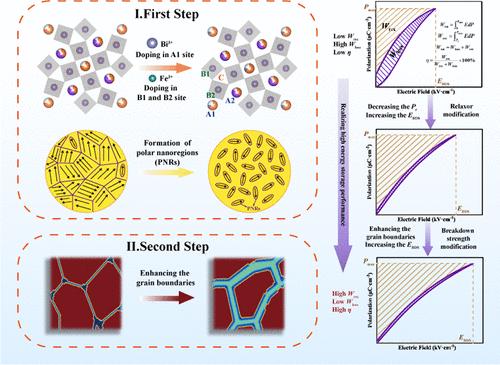通过弱耦合弛豫和晶界增强设计实现钨青铜基陶瓷优异的储能性能
IF 8.2
2区 材料科学
Q1 MATERIALS SCIENCE, MULTIDISCIPLINARY
引用次数: 0
摘要
介质陶瓷电容器以其高功率密度和快速充放电能力在下一代脉冲电源系统中发挥着至关重要的作用。然而,在实现大可回收能量存储密度(Wrec)方面仍然存在重大挑战。本文设计了一种基于Sr0.6Ba0.4Nb2O6 (SBN)的钨青铜弛豫铁电陶瓷,该陶瓷在740 kV·cm-1下的Wrec约为8.74 J·cm-3, η约为90.9%。结构表征表明,Bi3+和Fe3+的引入细化了晶体结构,并在四方钨青铜(TTB)晶格中引起了大量的不相称调制,导致弱耦合极性纳米区(pnr)的出现,并增强了弛豫行为。此外,CuO在晶界附近聚集,增强了晶界,提高了击穿场强(EBDS)。本研究提出了一种具有竞争力的基于ttb的无铅弛豫铁电陶瓷,并扩展了先进介质陶瓷电容器应用的材料范围。本文章由计算机程序翻译,如有差异,请以英文原文为准。

Realizing Exceptional Energy Storage Performance in Tungsten Bronze-Based Ceramics via Weakly Coupled Relaxor and Grain Boundary Reinforcement Designs
Dielectric ceramic capacitors play a crucial role in next-generation pulse power systems due to their high power density and rapid charge and discharge capabilities. However, significant challenges persist in achieving large recoverable energy storage density (Wrec). In this work, a tungsten bronze relaxor ferroelectric ceramic is designed based on Sr0.6Ba0.4Nb2O6 (SBN), which exhibits a significant Wrec of approximately 8.74 J·cm–3 and a high efficiency (η) of about 90.9% at 740 kV·cm–1. Structural characterizations reveal that the introduction of Bi3+ and Fe3+ refines the crystal structure and induces substantial incommensurate modulation in the tetragonal tungsten bronze (TTB) lattice, resulting in the emergence of weakly coupled polar nanoregions (PNRs) and enhancing the relaxor behavior. Moreover, the CuO that aggregates near the grain boundary results in a reinforced grain boundary and improves the breakdown field strength (EBDS). This study presents a competitive TTB-based lead-free relaxor ferroelectric ceramic and expands the range of materials available for advanced dielectric ceramic capacitor applications.
求助全文
通过发布文献求助,成功后即可免费获取论文全文。
去求助
来源期刊

ACS Applied Materials & Interfaces
工程技术-材料科学:综合
CiteScore
16.00
自引率
6.30%
发文量
4978
审稿时长
1.8 months
期刊介绍:
ACS Applied Materials & Interfaces is a leading interdisciplinary journal that brings together chemists, engineers, physicists, and biologists to explore the development and utilization of newly-discovered materials and interfacial processes for specific applications. Our journal has experienced remarkable growth since its establishment in 2009, both in terms of the number of articles published and the impact of the research showcased. We are proud to foster a truly global community, with the majority of published articles originating from outside the United States, reflecting the rapid growth of applied research worldwide.
 求助内容:
求助内容: 应助结果提醒方式:
应助结果提醒方式:


